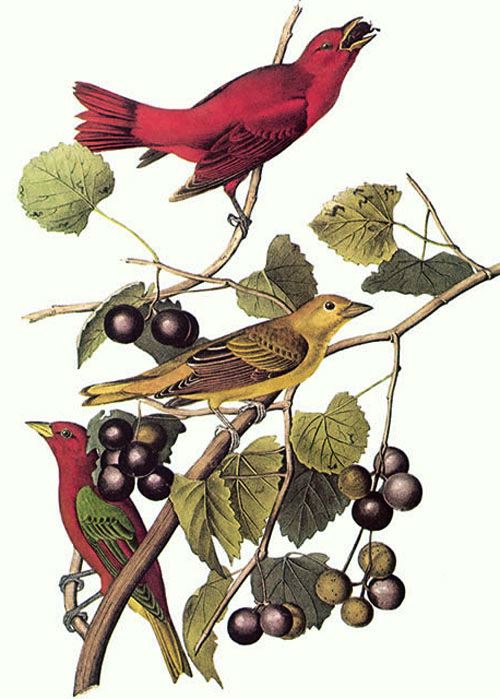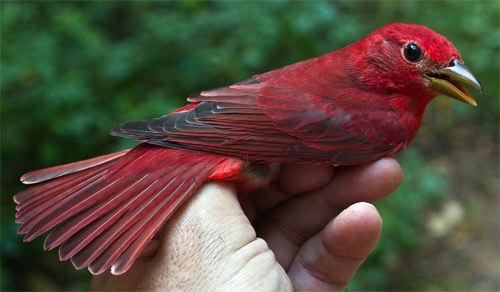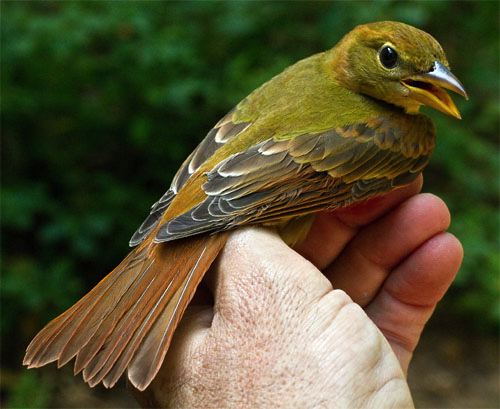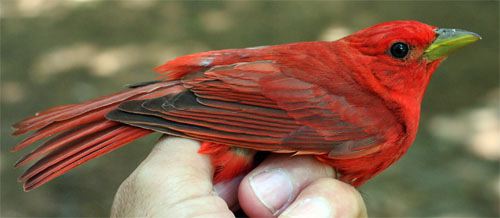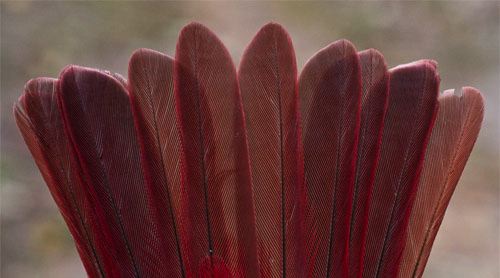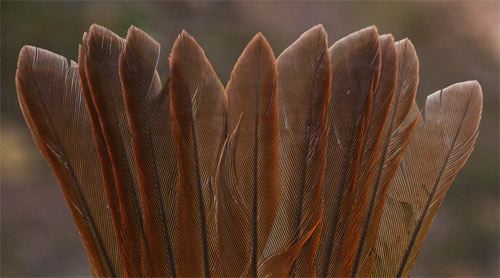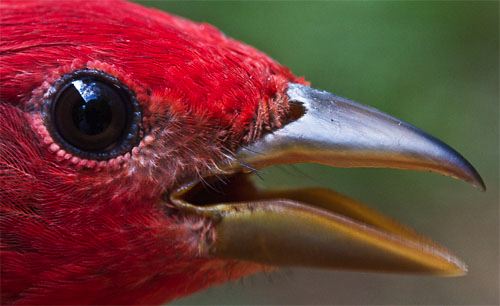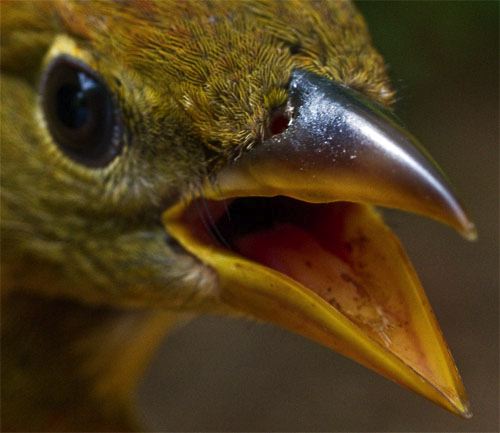|
John James Audubon's rendering of Summer Tanagers (above) LAST FULL DAY With the autumnal equinox occurring on 22 September at 11:09 p.m., summer's final FULL day in 2010 fell on the 21st. It was a terrific day filled with blue skies, a few puffy clouds, and an occasional light breeze, so it only seemed appropriate our last birds banded on summer's last full day turned out to be SUMMER Tanagers. Although we're likely to net a few more of these colorful birds before fall migration is over, they were a welcome and appropriate way to end the season.
All text & photos © Hilton Pond Center These two Summer Tanagers caught on 21 September were in the same net at the same time but were just about as different in appearance as Summer Tanagers ever get. One--a brilliant adult male (above)--had intense red plumage; the other was a greenish-yellowish-orangeish individual (below) we initially suspected to be an immature male but that required a bit more scrutiny before we finally confirmed its age and sex.
All text & photos © Hilton Pond Center Two tanager species occur at Hilton Pond Center: The Summer Tanager, Piranga rubra, that breeds here, throughout South Carolina, and north to about the Mason-Dixon Line; and the Scarlet Tanager, P. olivacea, that passes through in spring and fall. (Although scattered Scarlet Tanager nesting records exist from South Carolina's Upcountry, this species more typically breeds north of the Palmetto State up to New England and south central Canada.) We've never found a Summer Tanager nest at the Center but through the years have banded several recent fledglings and females with well-developed brood patches--both sure signs the species is breeding on or very close to our 11-acre site. And even though we see (and hear) Summer Tanagers early May through late September, we've banded only 181 since 1982--possibly because they seem more inclined to hang out in the subcanopy or higher and seldom come down to ground level for capture in our eight-foot-tall mist nets.
All text & photos © Hilton Pond Center There is some variation in color intensity among adult male Summer Tanagers in full breeding plumage; the one just above from 2004 has a slight yellowish cast while this week's bird at the top of the page is more crimson. Professional artists probably have a name for each of these various hues, but we're at a loss to describe them with mere words. Adult male Summer Tanagers, by the way, are the only completely red birds in North America; male Northern Cardinals come close but sport a black mask, and male Scarlet Tanagers have black wings.
All text & photos © Hilton Pond Center Some second-year male Summer Tanagers look like patchwork quilts, such as one (above) we caught during spring migration several years ago at Hilton Pond Center. This individual seemed 'way behind in his molt sequence but by his third year likely would have replaced all his green feathers with red. Whether these calico birds are vocal and aggressive enough to attract a female and mate successfully during their second year is anybody's guess. It seems ornithologists know little about the breeding biology of Summer Tanagers and even less about their behavioral ecology on wintering grounds from central Mexico to the northern countries of South America. (NOTE: We banded four Summer Tanagers at Crooked Tree during our March 2010 hummingbird expedition to Belize; we suspect all were soon to be northward bound.)
All text & photos © Hilton Pond Center That adult-looking male we caught this week did have one secret up his sleeve, or--more accurately--on his wings: Two primary feathers on each side were yellow-orange (above) rather than red like all the rest of his plumage. Some ornithologists report these two non-red feathers indicate he is a second-year bird, while other experts caution that he actually could be in his third year. Confusing, no?
Even more perplexing in Summer Tanagers is the similar appearance of females and immature males. Generally speaking, females of any age are more greenish and lack any true red feathers (as shown in Audubon's rendering at the top of the page), but the same can be said of many young males. In our novice banding years back in the last century, we were taught to look at a tanager's crissum--undertail coverts that overlap the bases of the tail feathers. The guideline was that a young male Summer Tanager has a bright yellow or yellow-orange crissum that contrasts strongly with paler yellow belly plumage--which is the case in the above photo of this week's bird. Some studies, however, have shown older females can have orange-tinted crissa--so we were understandably hesitant to call our bird-in-hand a young male.
All text & photos © Hilton Pond Center Because knowing our mysterious Summer Tanager's age might be a clue to determining its sex, we carefully examined the bird's tail feathers. Fortunately, we had photographed the rectrices of this week's adult male (above), so we had a good basis for comparison. In many bird species, the adults--those in at least their second year--have tail feathers that are truncate (more or less flat-tipped) or broadly rounded without sharp points. That certainly is the case in the adult male above.
All text & photos © Hilton Pond Center In contrast, the tail of the mystery tanager was a classic representation of immature plumage: Weakly formed, acute (pointed) rectrices that already were beginning to wear. There was no question about the bird's age--it was a youngster that hatched in 2010--but we still weren't sure of its sex and had to resort to the bird bander's ultimate strategy: When in doubt, measure! Based on measurements of many museum specimens--whose sex was determined via dissection of the dead birds' internal gonads--ornithologists concluded wing chords in male Summer Tanagers typically range from 90-101mm, with tails 63-72mm, while females have wings of 86-96mm and tails 62-70mm. Careful measurement of our in-hand bird showed an inconclusive wing chord of 92mm, but its tail was 72mm. Thus, because of its bright yellow crissum, its pointed rectrices, and the length of its tail, we FINALLY felt confident in calling this week's puzzling hatch-year Summer Tanager a male!
All text & photos © Hilton Pond Center We really like Summer Tanagers--not because their fledglings are so challenging to age and sex, but because we find their lifestyles fascinating. We once watched an adult male zip out repeatedly from a tree limb grabbing insects just like flycatchers do, except what the tanager was catching was paper wasps. These social insects had built a nest in the eaves of a house and each time a wasp would leave on a foraging mission the tanager would snatch it out of the air. Returning to its perch the bird would whack the wasp against the branch a few times, subdue it, and then swallow it whole. (Some observers report the tanager wipes the bee or wasp on a branch to remove its stinger, but we didn't observe this.) Such wasp- and bee-eating habits put Summer Tanagers in poor stead with beekeepers and pollination enthusiasts, but these colorful "Beebirds" also take important agricultural pests such as grasshoppers, beetles, and caterpillars too big for many birds to handle. We suspect a distinctive little "tooth" midway along the edge of the Summer Tanager's upper mandible (above and below) comes in quite handy when crunching down on wasps and oversized insects--something we had plenty of at Hilton Pond Center on the last full day of summer.
All text & photos © Hilton Pond Center Comments or questions about this week's installment?
Thanks to the following fine folks for recent gifts in support of Hilton Pond Center for Piedmont Natural History and/or Operation RubyThroat: The Hummingbird Project. Your tax-deductible contributions allow us to continue writing, photographing, and sharing "This Week at Hilton Pond." (Please see Support if you'd like to make a gift of your own. You can also contribute by ordering an Operation RubyThroat T-shirt.) Using Network for Good via Facebook's "Causes," some of the following individuals this week made contributions to "Help the Hummingbirds" in honor of Bill Hilton Jr.'s 64rd birthday on Costa Rica Independence Day (15 Sep). You, too, can still help by going to FaceBook. (Donations are still coming in and will be acknowledged in later installments of "This Week at Hilton Pond.") Your generosity is greatly appreciated and goes a long way in helping us implement the Center's education, research, and conservation activities.
"This Week at Hilton Pond" is written & photographed You may wish to consult our Index of all nature topics covered since February 2000. You can also use our on-line Hilton Pond Search Engine at the bottom of this page. For a free, non-fattening, on-line subscription to |
|
Make direct donations on-line via
Network for Good: |
|
|
Use your PayPal account
to make direct donations: |
|
|
If you like to shop on-line please become a member of iGive, through which more than 750 on-line stores from Amazon to Barnes & Noble, L.L. Bean to Lands' End--and even iTunes!--will donate a percentage of your purchase price in support of Hilton Pond Center and Operation RubyThroat. For every new member who signs up and makes an on-line purchase iGive will donate an ADDITIONAL $5 to the Center. You can even do Web searches through iGive and earn a penny per search for the cause! Please enroll by going to the iGive Web site; more than 200 members have signed up to help. It's a painless, important way for YOU to support our on-going work in conservation, education, and research. By the way, if you add the iGive Toolbar to your browser and register Operation RubyThroat as your preferred charity, it'll be even easier to help Hilton Pond when you shop. |
|
|
SPECIES BANDED THIS WEEK: * = New species for 2010 WEEKLY BANDING TOTAL 16 species 75 individuals 2010 BANDING TOTAL 39 species 923 individuals 218 Ruby-throated Hummingbirds 29-YEAR BANDING GRAND TOTAL (since 28 June 1982, during which time 170 species have been observed on or over the property) 124 species (29-yr avg = 67.8) 54,565 individuals (29-yr avg = 1,882) 4,267 Ruby-throated Hummingbirds (27-yr avg = 158) NOTABLE RECAPTURES THIS WEEK (with original banding date, sex, and current age) Ruby-throated Hummingbird (1) Carolina Chickadee (2) Northern Cardinal (2) |


